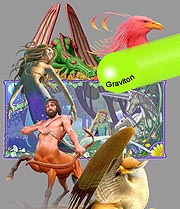Gravity and gravitons
 |
Legends have made a whole menagerie of mythical creatures, from centaurs to hippogryphs. The graviton is a proposed subatomic particle that causes gravity. However, since there is no experimental evidence substantiating its existence, for the moment the graviton remains mythical.
|
Without knowing a lot about a given topic, sometimes it's hard to separate fact from fiction. We might think the mythology of Ancient Greece to be silly with its Pegasus, mermaids and centaurs. Creatures with such a mix of properties are ridiculous, right? On the other hand, seeing the bizarre but very real platypus or sea dragon might give us pause and teach us not to be so quick to dismiss crazy-sounding reports.
In the early 1960s, physicists used the term "particle zoo" to describe the panoply of particles they had observed. With the advent of the Standard Model, scientists could predict particles that were required by the model but had not yet been discovered. The Higgs boson was one of those hypothesized particles, one that recently went from imagined to real. Another denizen of the subatomic mythical bestiary is the graviton, the force-mediating particle of gravity. While this particle is strictly outside the realm of the Standard Model, it seems like it could be more than just imaginary, given that the other three forces each have an associated quantum particle.
We know of four forces in the universe: the strong and weak nuclear forces, electromagnetism, and gravity. In the world of the super-small, the first three of these forces can be viewed as the exchange of force-mediating particles. It's a fair question to ask whether gravity also follows this pattern.
While gravity is the most familiar of all the forces, it is also the weakest. To give a sense of scale, it is 0.0000000000000
0000000000000000000001 or so times smaller than the next weakest force, the weak nuclear force. Given that particles experiencing only the weak nuclear force can penetrate five light-years of solid lead without interacting, gravity is very weak indeed.
Gravity is so weak that it is difficult to imagine ever seeing its effects in the quantum realm. Studies of gravity generally involve the human and the cosmic scales, with stars guiding planets and planets pulling people down to the ground. It takes countless particles to exert an appreciable gravitational force.
However, the success of quantum field theories to describe the other three forces, each with its own particle or particles mediating it, leads us to think that perhaps there might also be a quantum particle of gravity. This hypothetical particle is called the graviton.
Bringing us back to the idea that kicked off this Nutshell, I should caution you that there is no evidence that the graviton exists. It's merely an idea cooked up in the fertile imaginations of theoretical physicists. Still, given the nature of the gravitational force, we know what properties the graviton would have to possess. It would have to be massless to account for the infinite range of gravity and be electrically neutral. It would have to have a quantum mechanical spin of 2 to account for gravity's attractive qualities. It would have to be a fundamental particle (that is, have nothing inside it). And it would have to interact with mass as the "charge" of gravity.
Physicists have proposed ideas for graviton properties in addition to the above-listed must-haves. If there are extra dimensions in the universe, then we can reasonably put forward other ideas about gravitons, including ones that are massive and that have exotic spin states. These are theoretically credible ideas, and scientists at the LHC are looking for them. However, since we don't even know if the ordinary gravitons that would govern the orbits of the planets exist, these exotic gravitons are even sketchier ideas.
The bottom line with the graviton is that it is a perfectly reasonable idea and may well be true. However, it has never been observed. And, until it is, we don't know if it's a scientific mermaid or a sea dragon.
—Don Lincoln
Want a phrase defined? Have a question? E-mail today@fnal.gov.
|